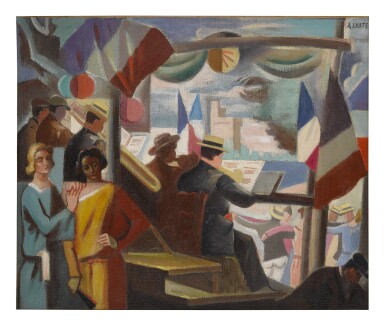
Cubism and Beyond
ANDRÉ LHOTE | 14 JUILLET EN AVIGNON
Lot Closed
June 23, 04:10 PM GMT
Estimate
100,000 - 150,000 USD
Lot Details
Description
Cubism and Beyond
ANDRÉ LHOTE
(1885 - 1962)
14 JUILLET EN AVIGNON
Signed A. Lhote. (upper right)
Oil on canvas
22¾ by 27½ in. (58 by 70 cm)
Framed: 33 by 37½ in. (83.8 by 95.2 cm)
Painted in 1930.
This work will be included in the forthcoming catalogue raisonné being prepared by Dominique Bermann Martin.
Anne Fonjalles, Paris (acquired from the artist)
Sale: Christie's, London, April 3, 1990, lot 361
Sale: Loudmer Scp., Paris, June 16, 1990, lot 102
Private Collection, Switzerland (and sold: Sotheby's, London, June 25, 1997, lot 329)
Private Collection, Europe (acquired at the above sale)
Acquired from the above in 2015
Lyon, Hommage à André Lhote, 1962, n.n.
Anatole Jakovsky, André Lhote, Paris, 1947, no. 26, illustrated n.p.
A celebration of French culture conveyed through Cubist principles, 14 Juillet en Avignon represents what Lhote deemed the “return to order” following the devastation of World War I. Cubism had been criticized for its overt anti-establishment aesthetic and adjacency to a Germanic conventionality which the French ultimately blamed for the War, but Lhote saw a mode through which the aesthetic could be seen in line with core Francophone values. In a letter from Lhote to the intellectual Jacques Rivière in 1913, he “sent a chart demonstrating how Cubism had resumed the most important essentials of the primitives, the Renaissance and the school of David, about which Rivière had just written in NRF. In the same letter he explained that the mistake of the Impressionists was not in attempting to fix a sensation, but it not knowing how to bring this into the tradition” (Jane Lee, ed. Malcolm Glee, Art Criticism Since 1900, London, 1993, p. 87). Lhote’s decisive belief that the artist had a moral obligation to embrace historical French culture is nowhere as outwardly asserted as in 14 Juillet en Avignon. Presented with the inhabitants of a provincial French village in the midst of Independence Day celebrations in the style of Salon Cubism, we see sharp lines consistent with Medieval French architecture, further integrating notions of French historical patrimoine. One of multiple undertakings of this subject, two other versions of the present work are held in the collections of the Musée national d'art moderne, Centre Georges Pompidou, Paris and the Musée des beaux-arts, Paris respectively.
